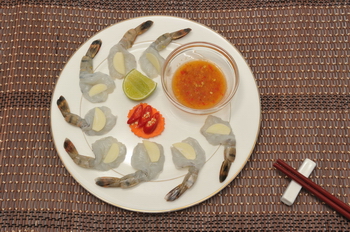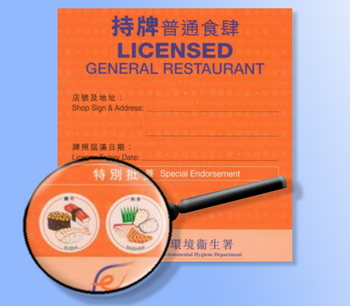
Food Safety Focus (62nd Issue, September 2011) – Incident in Focus
In Search of Safe Shrimp Sashimi
Reported by Dr. Ken CHONG, Scientific Officer,
Risk Assessment Section, Centre for Food Safety
From February to July this year, the Centre for Food Safety (CFS) investigated three food poisoning outbreaks in Thai restaurants in which the affected people reported that shrimp sashimi and other food had been consumed. Eleven people were affected in these outbreaks and the suspected causative agents included Vibrio parahaemolyticus only or with Salmonella species.

Thai-style shrimp sashimi
Seafood may harbour pathogenic microorganisms. In comparison with cooked food, raw foods including different types of sashimi are of higher risk. While cooking seafood thoroughly is the best way to minimise the risk of foodborne illness, many people prefer the raw taste of sashimi and take the additional risk.
Sources of Contamination of Sashimi
Since shrimp sashimi is consumed without further cooking, pathogenic microorganisms present in the water environment of the shrimps that might have contaminated the sashimi may cause foodborne illness. Vibrio parahaemolyticus occurs naturally in coastal and estuarine environments in tropical to temperate zones. It may be carried in seafood products in these areas, such as shrimp, mussel, raw oysters, and can grow rapidly under favourable conditions. Both raw/partially treated seafood products no doubt are of high risk. Although thorough cooking can eliminate the bacterium, the products may be recontaminated through contaminated utensils, hands, etc.
Salmonella species are not naturally occurring microorganisms in water environment, but it may be introduced through environmental contamination by domestic and/or industrial wastes, including animal wastes. In addition, cross-contamination may occur when the raw shrimps and contaminated animal products, such as poultry meat, are handled in the same area or improperly stored together in a refrigerator.
High Hygiene Requirement for Preparing Shrimp Sashimi
As sashimi is a type of high risk food, food handlers should observe the hygiene practice for preparing and selling shrimp sashimi, as well as other types of sashimi, no matter in Thai or Japanese restaurants. Separate portions of the restaurants should be designated for preparing sashimi and separate equipments with label should be used for such purpose to ensure there is no cross-contamination with other foods or environmental contamination. Food handlers are required to wear clean protective clothing including head coverings. They should handle the food properly and cleanse or sterilise the tools properly. Food to be eaten in its raw state must be kept separately. Defrosted raw materials for the preparation of sashimi should be kept under 4oC and those with slimy surface, in dripping state or of dull colour must be immediately discarded.
The source of the shrimps affects the quality of the final products. Raw materials for the preparation of sashimi should be sound, wholesome and of good quality and should be obtained from a reliable and reputable source. Raw shrimps intended for hotpot are of high risk of food poisoning if consumed raw. Consumers should not take the risk and trade members are advised not to provide these shrimps for consumption in their raw state. All imported food materials should be accompanied by health certificates issued by relevant authority of the exporting countries which are acceptable to the Food and Environmental Hygiene Department (FEHD). Under the Food Safety Ordinance, all restaurants are required to keep records of acquisition of food for examination.

FEHD license with specific endorsement for manufacturing and sale of sushi and sashimi
Key Points to Note:
-
Shrimp sashimi may be contaminated with foodborne pathogens as a result of environmental contamination or unhygienic handling practice.
-
Food handlers should observe the hygiene practice for preparing and selling sashimi.
-
Consume only shrimp sashimi prepared in restaurants permitted to sell sashimi.
Advice to Trade
-
Raw materials for the preparation of sashimi should be sound, wholesome and of good quality, and should be obtained from a reliable source.
-
Prepare sashimi only at the designated and labelled areas in food preparation room.
-
Use exclusive cutting boards and knives for sashimi; clean and disinfect the utensils thoroughly before handling different types of sashimi food.
Advice to Consumers
- Before ordering sashimi and sushi in restaurants, check whether the premises have a FEHD licence and have the endorsement for sale of sashimi and sushi.
- Check if sashimi and sushi are fresh and kept under suitable temperature when enjoy them.
- People with weakened immunity, elderly, pregnant women and young children are at higher risk for foodborne illness; they should not eat raw or partially cooked food.

